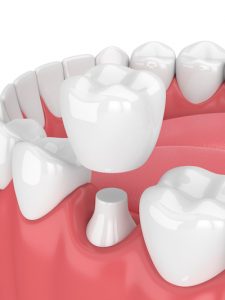What are Dental Crowns?

A dental crown is essentially a sturdy cap, shaped and colored to resemble your natural tooth, which is placed over an existing tooth. It’s then cemented in place, usually encasing the entire existing tooth (at least, the portion of it that extends above the gum line). Crowns are used to restore the appearance of a tooth, to increase its size, to alter its shape, or to strengthen and protect it.
Types of Material Used for Crowns
There are many different types of crowns, and many different types of materials used to create them. Here are a few of those materials:
- Stainless Steel Crowns: Stainless steel dental crowns are generally used as a temporary measure. They’re pre-fabricated in a variety of shapes and sizes and are used while the permanent crown is still being created. The stainless steel crown generally fits over the tooth that requires repair in order to protect it from further damage or decay until the permanent crown can be placed. They are also sometimes used in lieu of permanent crowns over children’s primary teeth, since they are more affordable. They usually only require one visit to be placed.
- Metal Alloy Crowns: Other metal crowns also exist, typically created using a variety of different alloys. These alloys can include gold, platinum, cobalt-chromium, nickel-chromium, or other base-metal alloys. Metal crowns are known to be extremely sturdy and are able to withstand biting, chewing, and other forces on the teeth exceptionally well, and are among the longest-lasting crown options. They rarely break, chip, or wear down. While metal crowns are extremely durable and long-lasting, many people don’t care for their appearance, especially for teeth that are typically visible to others when smiling or talking. Many people do, however, opt for metal crowns for out-of-sight teeth, like molars.
- Porcelain-fused-to-metal Crowns: These crowns can be much more natural in appearance than metal crowns. Along with ceramic crowns, porcelain-fused-to-metal crowns are the most realistic in appearance and are popular for that reason. However, they aren’t as durable as some other types of crowns, with the metal sometimes becoming visible when the porcelain chips or wears away from the gum line. They also cause the opposing teeth to wear down more quickly. They’re usually used for front teeth and long bridges which require the metal foundation for additional strength.
- All-resin Crowns: While all-resin crowns are reasonably natural-looking and are one of the most affordable options available, they aren’t as durable as most of the others. For example, porcelain and metal crowns are less prone to fractures and wear and tear as compared to all-resin crowns.
- All-ceramic/All-porcelain Crowns: Crowns that are composed entirely of either ceramic or porcelain are preferred by many for cosmetic reasons. Their color, texture, and overall appearance are more natural than any other type of crown. They are also ideal for people who have metal allergies or sensitivities.
A Note on Temporary vs. Permanent Crowns
If your tooth is damaged to the point that it is unsafe for it to remain uncovered until your permanent crown is fabricated, your Anchorage dentist may affix a temporary crown. As we’ve already mentioned, stainless steel crowns are sometimes used for this purpose. There are also temporary crowns made of acrylic-based materials.
These temporary crowns are used because a permanent crown that’s customized for your specific tooth usually aren’t made at your dentist’s office. While your dentist will take casts and measurements, they send these measurements to an off-site professional lab, where the crown is constructed and then delivered back to your dentist’s office when complete.
Why You Might Need a Dental Crown
There are many different reasons that your tooth might require the additional protection and strength offered by a professionally applied dental crown. Here are just a few of those reasons:
- It’s been weakened by decay: If your tooth has been weakened by decay or otherwise damaged, a crown may be required to protect it from further damage.
- It’s cracked: While a cracked tooth sometimes needs to be extracted, in many cases if the tooth is otherwise healthy, it can be covered by a crown instead. If so, the crown is designed to hold the parts of the cracked tooth together.
- It’s broken: Sometimes a tooth breaks, but the root is still relatively healthy. If this is the case, a crown can be used to restore its appearance and functionality.
- It’s worn down: Just as a tooth might be broken but have an otherwise healthy foundation, the same can be true for worn-down teeth.
- You have a dental bridge: A crown can be used to hold a dental bridge in place.
- Cosmetic purposes: Extremely discolored or misshapen teeth can be a blow to one’s self esteem. A crown can improve their appearance.
Average Cost of Dental Crowns
The cost of your dental crown will vary a great deal depending on the type of material used and other factors. Generally speaking, dental crowns in Anchorage range from $1650 to $1850. If you think you might need a crown, call us today!
